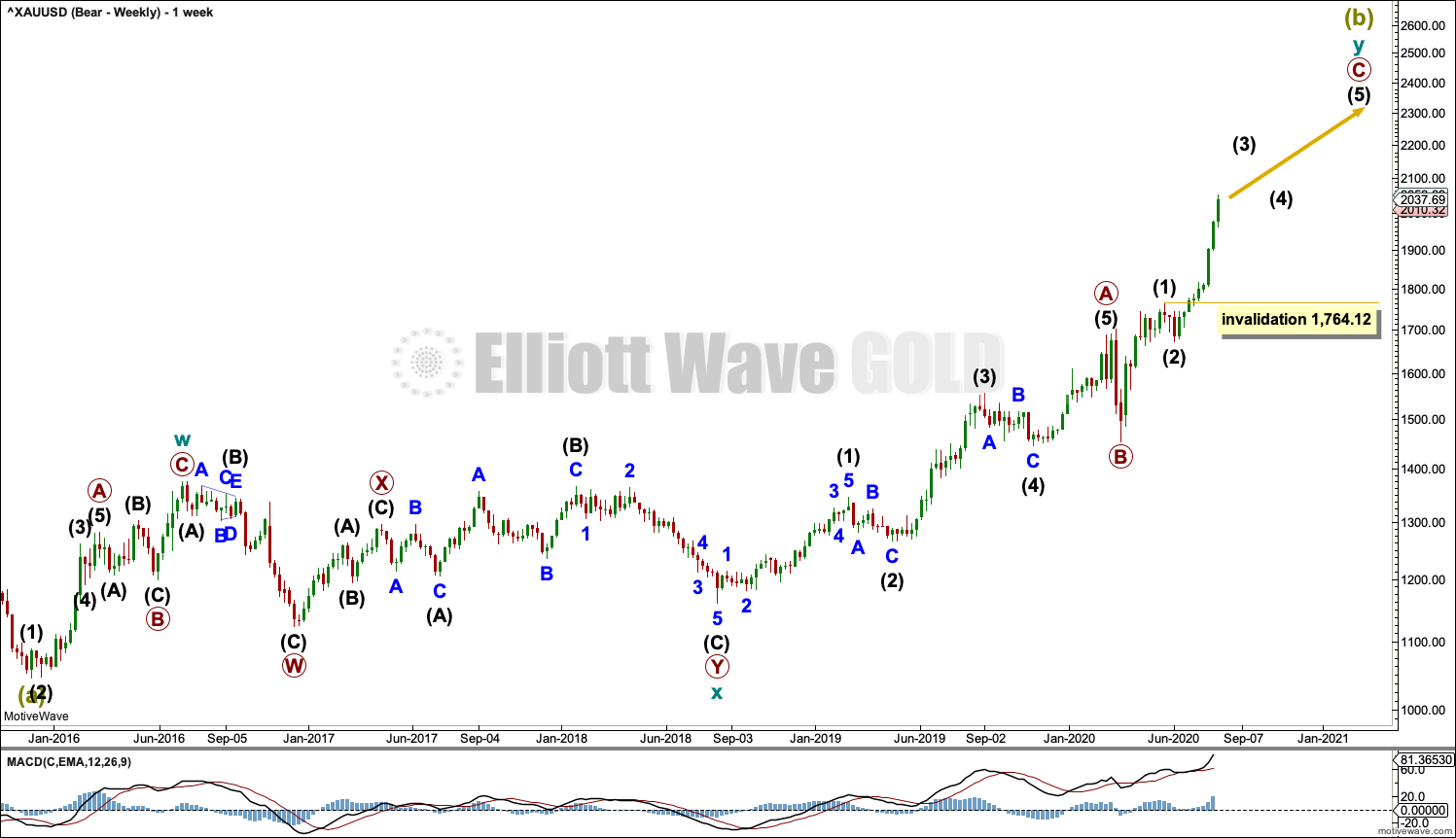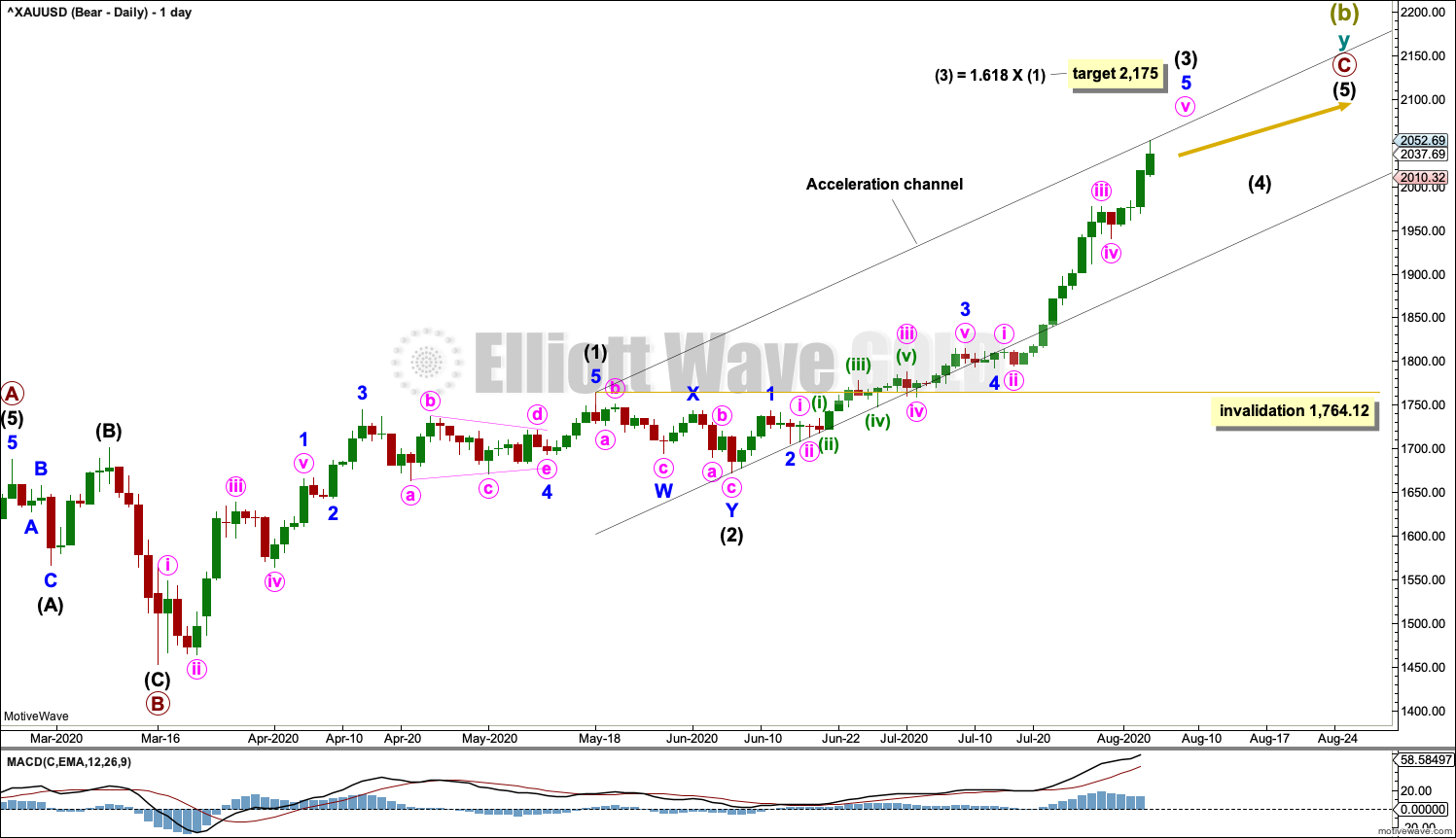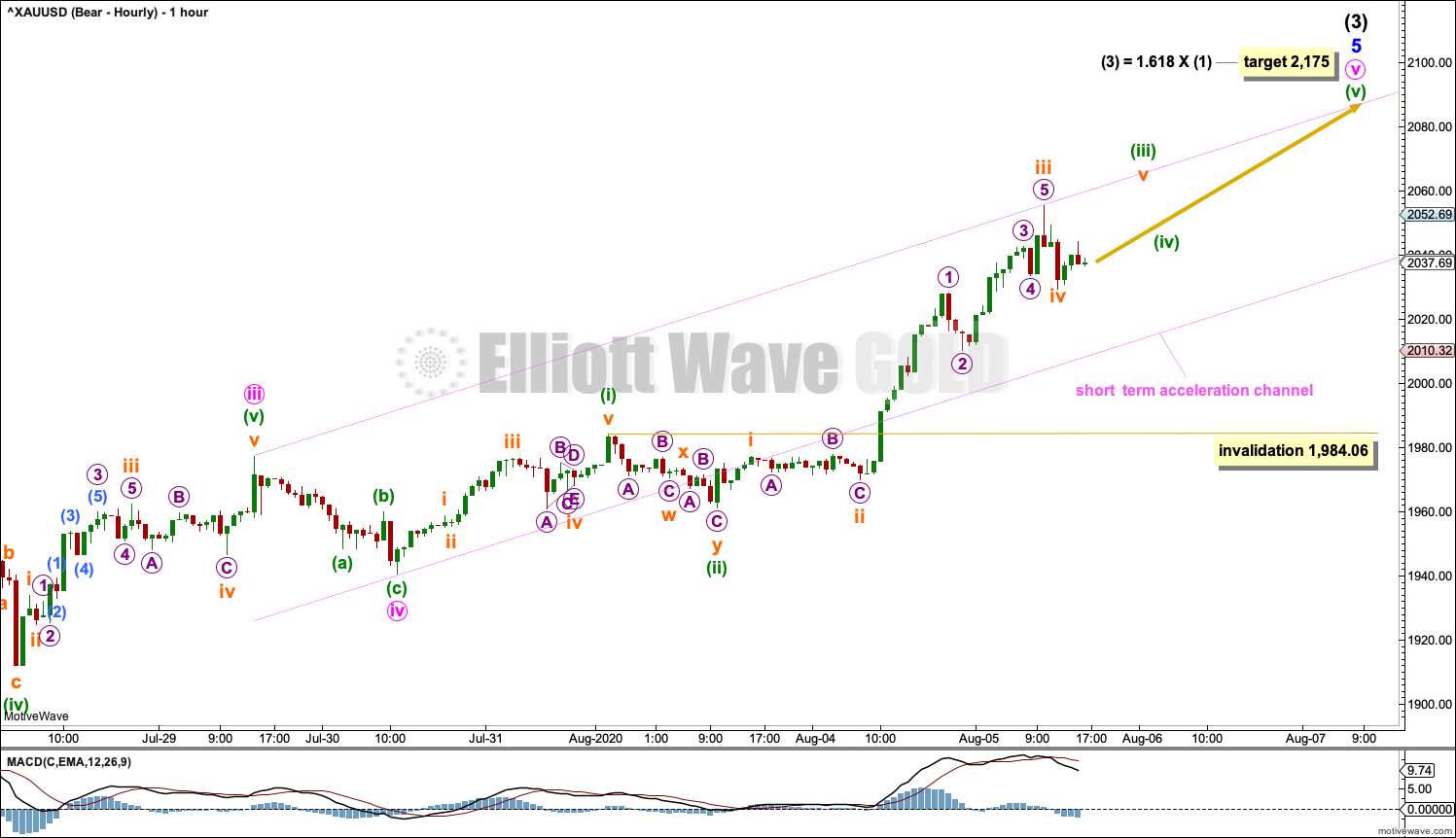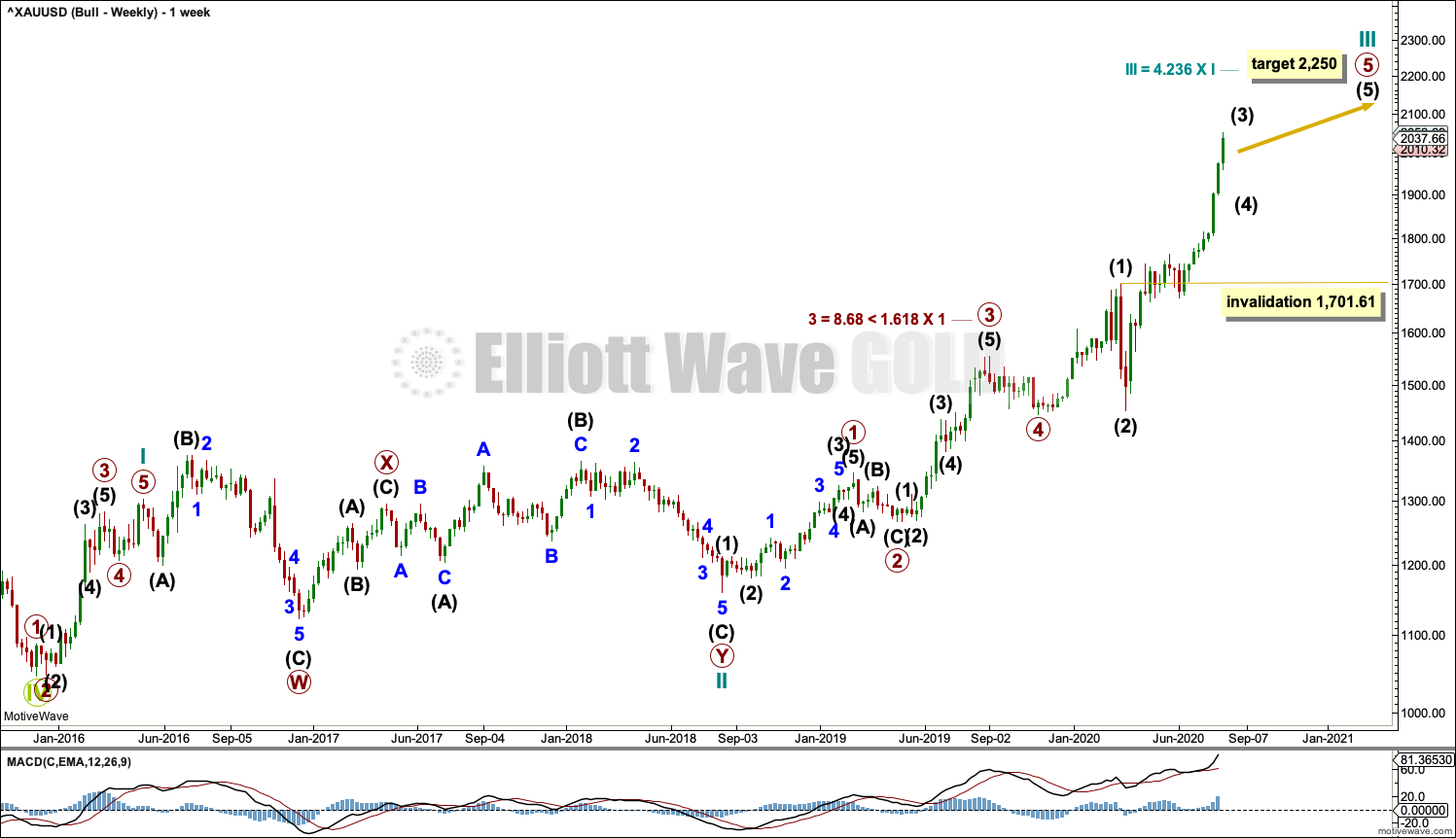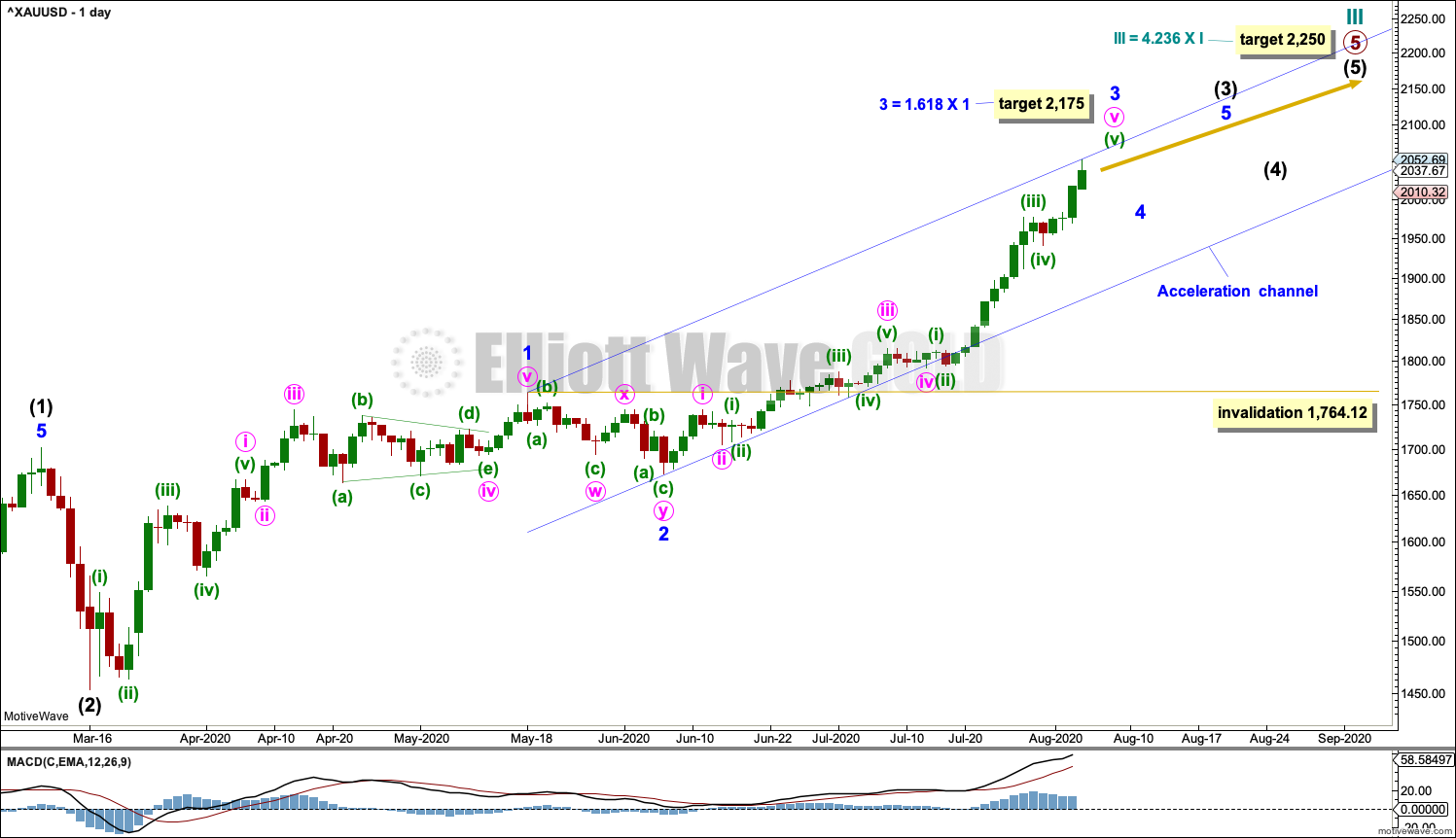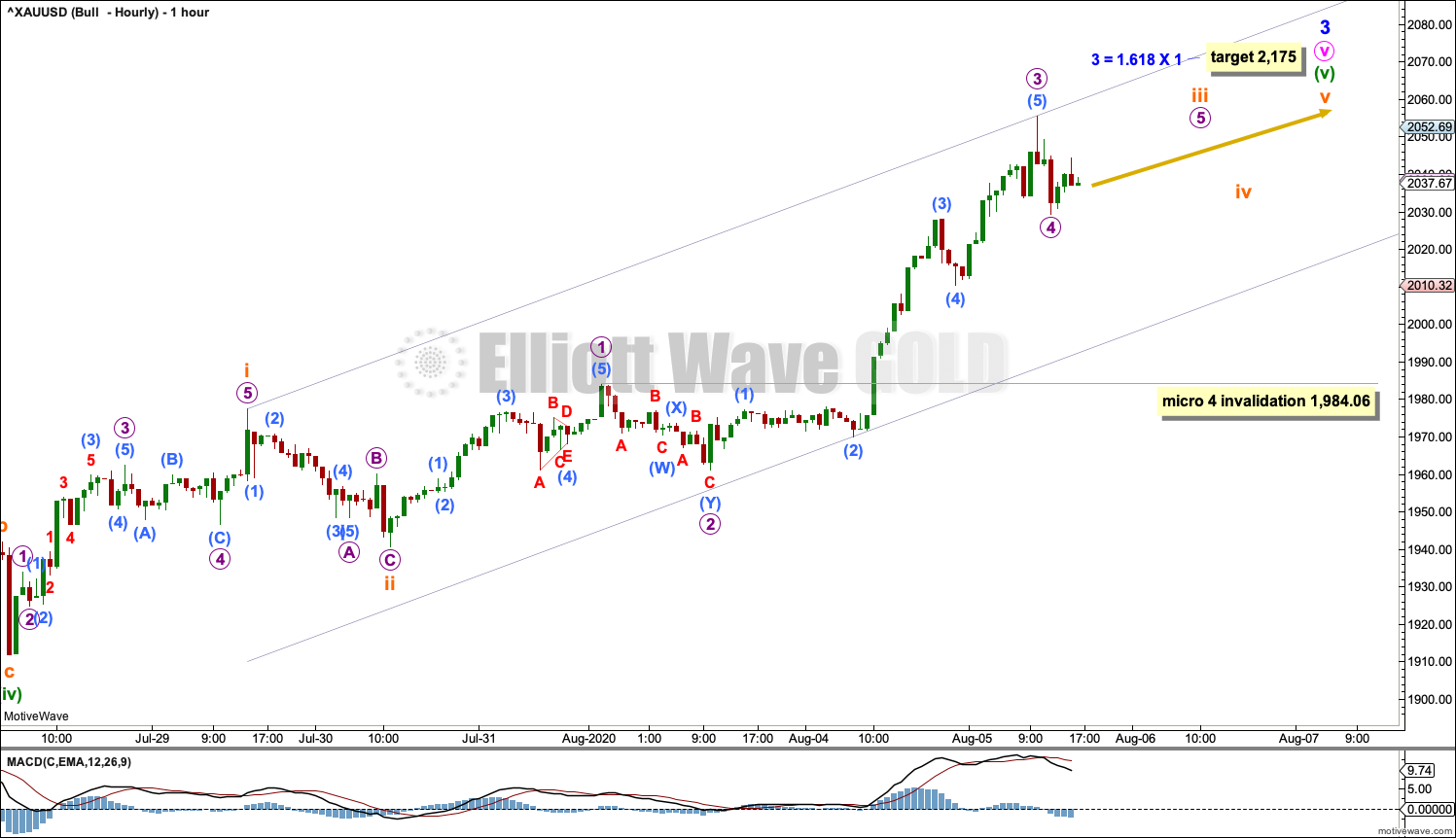GOLD: Elliott Wave and Technical Analysis | Charts – August 5, 2020
Price continues to move higher towards the next target.
Summary: The next target is at 2,175. About this target a multi-week consolidation or pullback may begin. Thereafter, the upwards trend may resume.
The next longer-term target is at 2,250 or 2,306.
Grand SuperCycle analysis is here.
Last analysis of monthly charts is here with video here.
BEARISH ELLIOTT WAVE COUNT
WEEKLY CHART
The bigger picture for this main bearish Elliott wave count sees Gold as still within a bear market, in a three steps back pattern that is labelled Grand Super Cycle wave IV on monthly charts.
Super Cycle wave (b) within Grand Super Cycle wave IV may be an incomplete double zigzag. When Super Cycle wave (b) may be complete, then this wave count expects Super Cycle wave (c) to begin and to move price below the end of Super Cycle wave (a) at 1,046.27.
The first zigzag in the double is labelled cycle wave w. The double is joined by a three in the opposite direction, a combination labelled cycle wave x. The second zigzag in the double is labelled cycle wave y.
The purpose of the second zigzag in a double is to deepen the correction. Cycle wave y has achieved this purpose.
Primary wave C within cycle wave y may be subdividing as an impulse. Intermediate waves (1) and (2) within primary wave C may be complete. Intermediate wave (3) may be continuing higher. Intermediate wave (4) may not move into intermediate wave (1) price territory below 1,764.12.
We should always assume the trend remains the same until proven otherwise. At this stage, Gold is in a bull market.
DAILY CHART
The daily chart shows detail of primary wave C as an incomplete impulse.
Intermediate waves (1) and (2) within primary wave C may be complete. A target is calculated for intermediate wave (3) to exhibit a common Fibonacci ratio to intermediate wave (1).
Intermediate wave (4) may not move into intermediate wave (1) price territory below 1,764.12.
Draw an acceleration channel: draw a first trend line from the end of intermediate wave (1) to the last high, then place a parallel copy on the end of intermediate wave (2). Keep redrawing the channel as price moves higher. When intermediate wave (3) may be complete, then this channel would be an Elliott channel. Intermediate wave (4) may find support about the lower edge.
At 2,175 intermediate wave (3) would reach 1.618 the length of intermediate wave (1).
HOURLY CHART
Intermediate wave (3) is continuing higher. It may end with an increase in upwards momentum. Fifth waves to end third waves one degree higher may form blow off tops.
Minute wave v to end minor wave 5 may be unfolding as an impulse. Minuette waves (i) and (ii) within the impulse may be complete. Minuette wave (iii) may be nearing completion. Minuette wave (iv) may not move into minuette wave (i) price territory below 1,984.06.
Draw a short-term acceleration channel on the hourly chart. In the first instance expect support at the lower edge for any deeper pullbacks along the way up. If this channel is breached by downwards movement, it may be an early indication that intermediate wave (3) may possibly be over.
ALTERNATE BULLISH ELLIOTT WAVE COUNT
WEEKLY CHART
This wave count sees the the bear market complete at the last major low for Gold on 3 December 2015.
If Gold is in a new bull market, then it should begin with a five wave structure upwards on the weekly chart.
Cycle wave I fits as a five wave impulse with reasonably proportionate corrections for primary waves 2 and 4.
Cycle wave II fits as a double flat. However, within the first flat correction labelled primary wave W, this wave count needs to ignore what looks like an obvious triangle from July to September 2016 (this can be seen labelled as a triangle on the bear wave count above). This movement must be labelled as a series of overlapping first and second waves. Ignoring this triangle reduces the probability of this wave count in Elliott wave terms.
Within the first flat correction labelled primary wave W of the double flat of cycle wave II, intermediate wave (B) is 1.69 the length of intermediate wave (A). This is longer than the common range of up to 1.38, but within an allowable guideline of up to 2. The length of intermediate wave (B) reduces the probability of this wave count.
Cycle wave III may be incomplete. Cycle wave IV may not move into cycle wave I price territory below 1,303.51.
DAILY CHART
Cycle wave III may be continuing higher. The daily chart focusses on the end of primary wave 5 within cycle wave III.
Draw an acceleration channel about intermediate wave (3): draw the first trend line from the end of minor wave 1 to the last high, then place a parallel copy on the end of minor wave 2. Keep redrawing the channel as price moves higher. When minor wave 3 may be complete, then this channel would be drawn using Elliott’s technique. Minor wave 4 may find support about the lower edge of the channel.
Minor wave 4 may not move into minor wave 1 price territory below 1,764.12.
HOURLY CHART
Both hourly wave counts expect upwards movement. Both have targets and invalidation points and channels that are the same at this stage.
TECHNICAL ANALYSIS
WEEKLY CHART
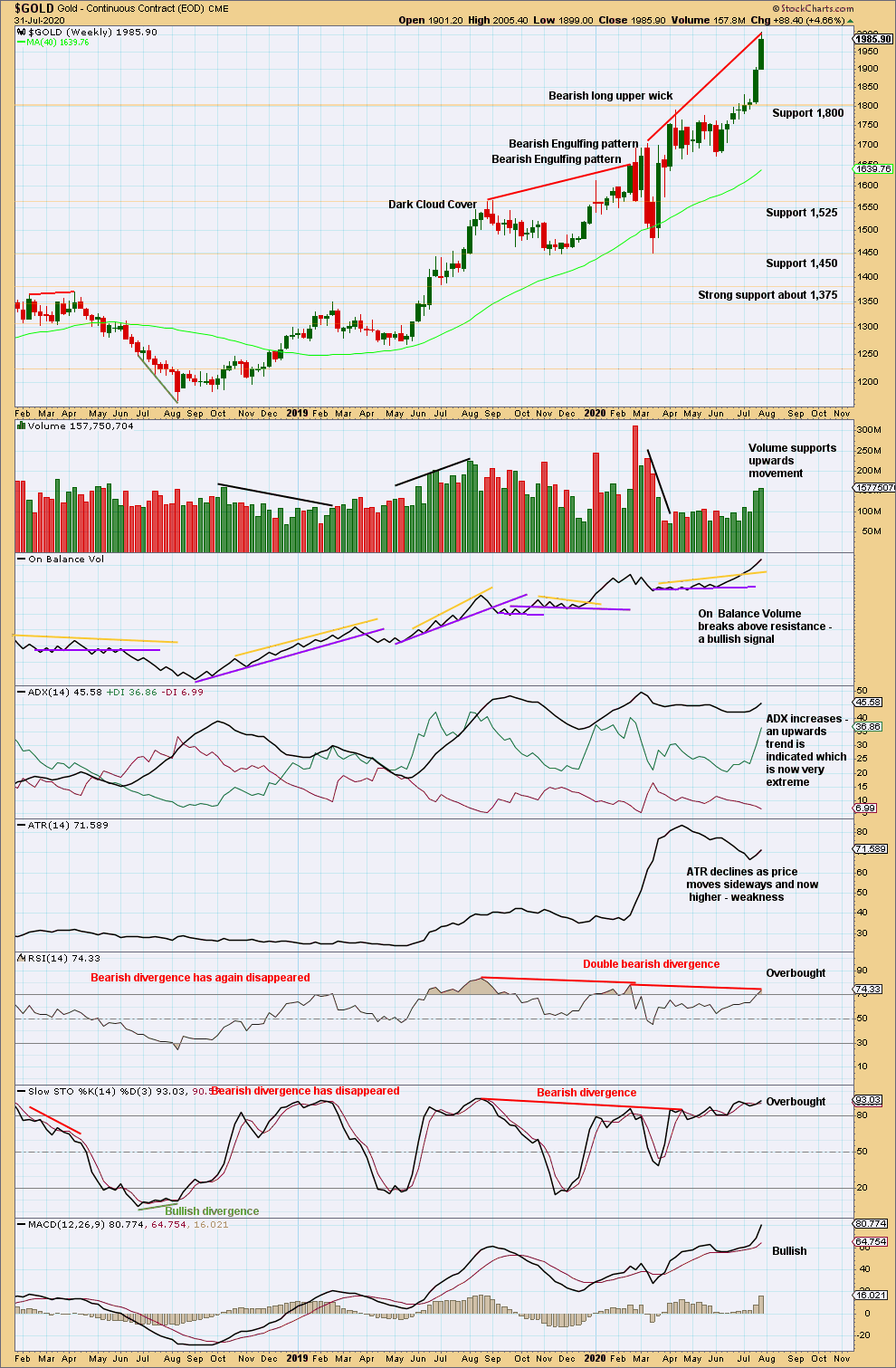
Click chart to enlarge. Chart courtesy of StockCharts.com.
The upwards trend at this time frame is now very extreme. RSI exhibits double bearish divergence with price (although this has weakened last week). The risk of a trend change or large consolidation here is increasing, but there is still no signal of a trend change.
DAILY CHART
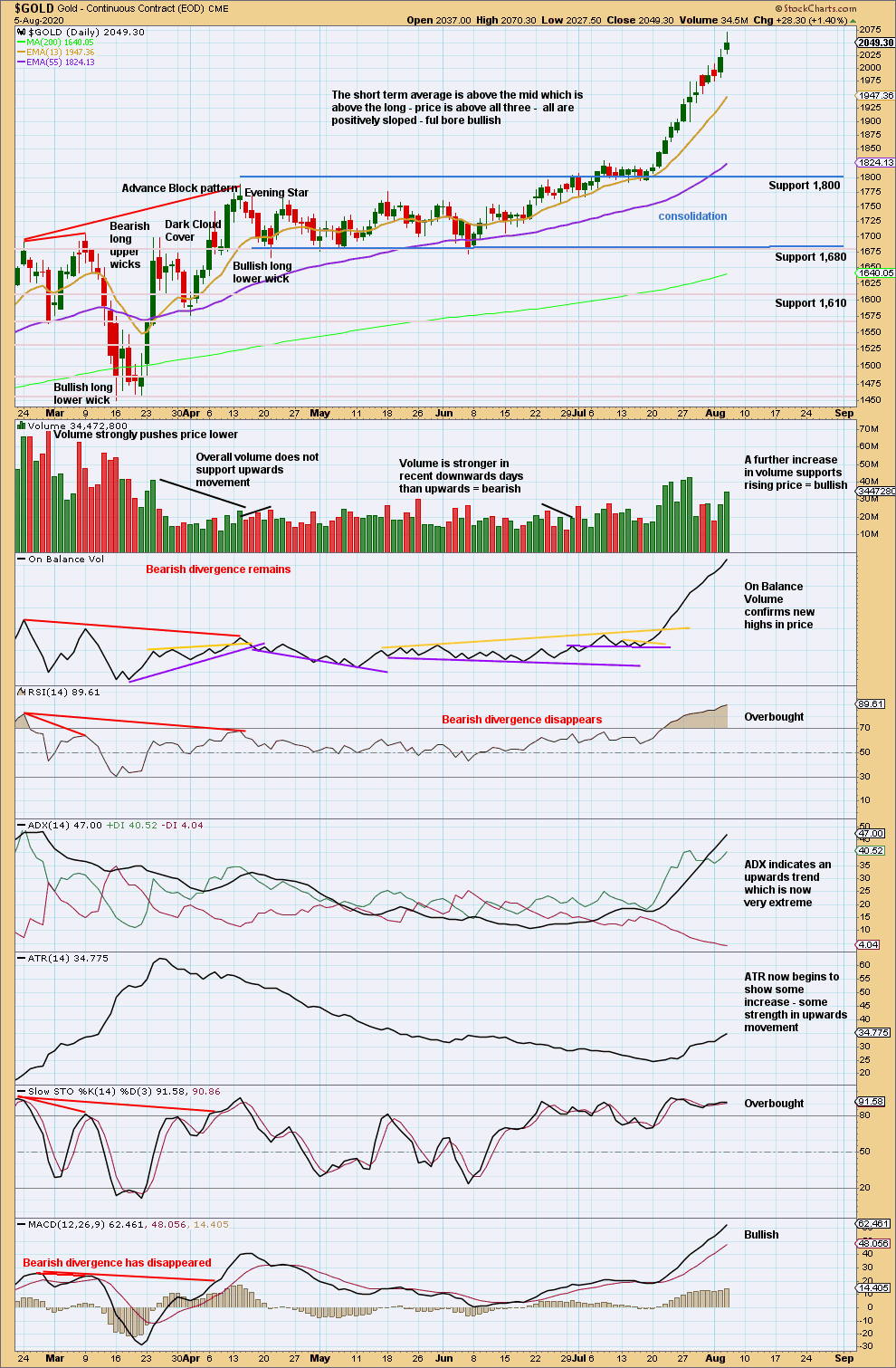
Click chart to enlarge. Chart courtesy of StockCharts.com.
Assume the upwards trend remains the same until proven otherwise.
Conditions are now very extreme; RSI is deeply overbought, and ADX is very extreme.
Conditions can continue to become more extreme while price can travel a reasonable further distance. A bearish candlestick reversal pattern should be watched for to indicate an end to this trend. A bearish candlestick pattern occurring in current conditions should be given weight.
GDX WEEKLY CHART

Click chart to enlarge. Chart courtesy of StockCharts.com.
A spinning top after a strong upwards trend indicates caution, but on its own it is not a reversal signal.
GDX DAILY CHART
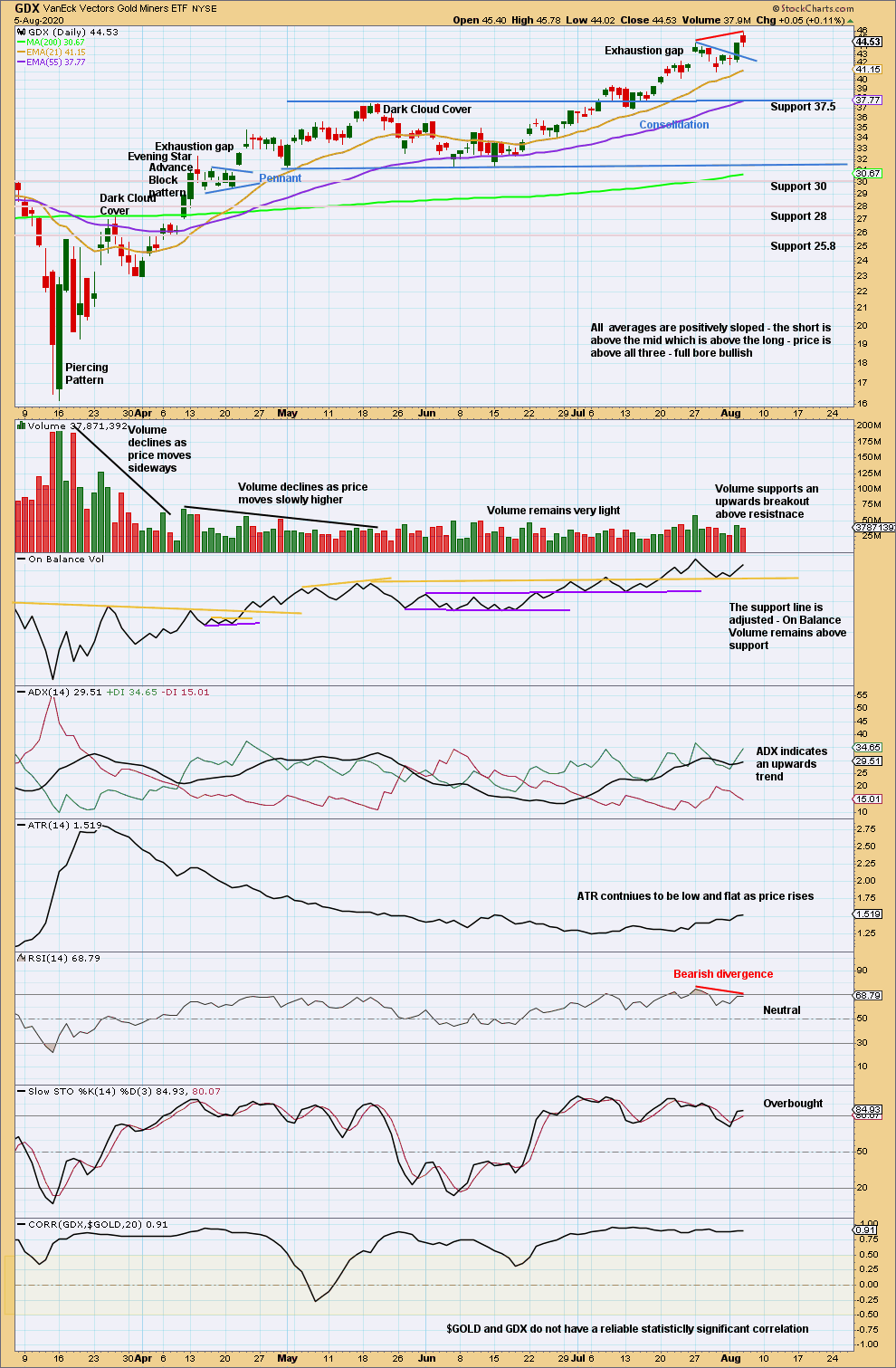
Click chart to enlarge. Chart courtesy of StockCharts.com.
An upwards close above prior resistance on a day that has support from volume is bullish. A new target taken from the last upwards wave is at 50.55.
However, bearish divergence with RSI is now stronger and the last candlestick has closed red. This is not a reversal pattern, but it is bearish. The risk of a sharp reversal here is high.
Published @ 06:14 p.m. ET.
—
Careful risk management protects your trading account(s).
Follow my two Golden Rules:
1. Always trade with stops.
2. Risk only 1-5% of equity on any one trade.
—
New updates to this analysis are in bold.

